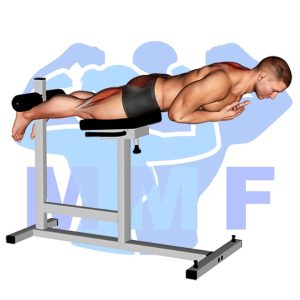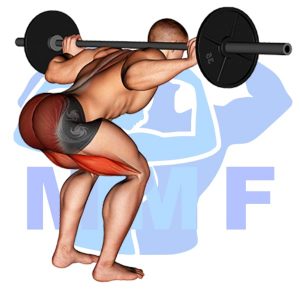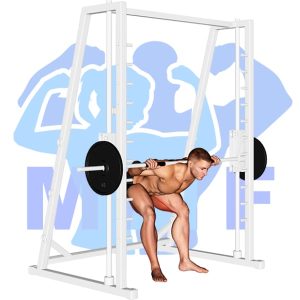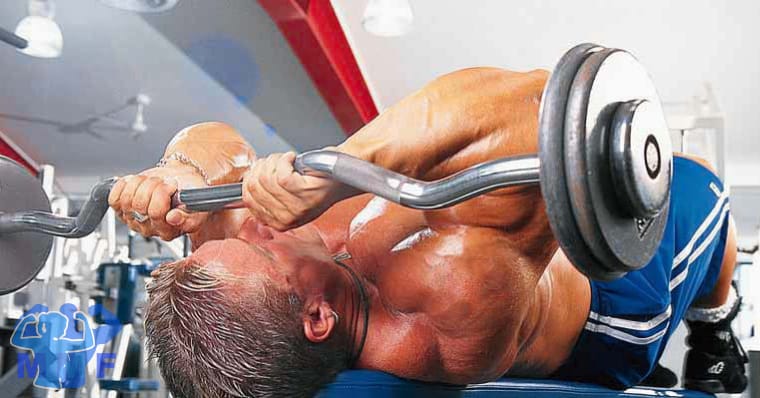Have you ever experienced lower back pain during or after a workout? It’s a common problem that many of us face, especially when performing exercises that involve the lower back. One culprit for this pain might be the plate hyperextension exercise. While this exercise can help strengthen your erector spinae, it can also cause discomfort or injury if not executed correctly. Don’t worry; you’re not alone in this struggle. In this blog post, we’ll dive deeper into the causes of plate hyperextension-related lower back pain and provide you with tips and techniques to help you perform this exercise with confidence and safety.
Plate Hyperextension Summary
- Primary Muscles: Erector Spinae
- Secondary Muscles: Gluteus Maximus, and Hamstrings
- Equipment: Hyperextension Machine
- Mechanics Type: Compound
- Force: Pull
- Utility: Basic or Auxiliary

Plate Hyperextension Instructions
- Lie on your stomach on an exercise mat.
- Place your feet against a flat bench or platform.
- Place your elbows on the ground, directly under your shoulders.
- Extend your arms, lifting your upper body off the ground.
- Hold for a few seconds, then return to the starting position.
Video Tutorial
Plate Hyperextension Muscles
Target (Agonist)
Synergists
Dynamic Stabilizers
- None
Stabilizers
Antagonist Stabilizers

Benefits of Plate Hyperextension
The Plate Hyperextension exercise is a great way to strengthen the Erector Spinae muscles, which are located in the lower back and run along the spine. This exercise helps to improve posture and reduce lower back pain, while also strengthening core stability and increasing flexibility. Additionally, by adding weight plates to the exercise, it can help to increase the intensity of the workout, which can help to increase muscle mass and tone in the Erector Spinae.
Tips for Performing Plate Hyperextension
The Plate Hyperextension exercise is a great way to strengthen your lower back, core, and glutes. Using the proper form is essential to ensure that you get the most out of this exercise and avoid any potential injury. To help you get the best results from this exercise, we have compiled a list of tips below. Read on to learn how to properly perform Plate Hyperextensions and reap the full benefits of this exercise!
- Ensure you have the correct form: To maximize results from the Plate Hyperextension, make sure you have the correct form. Keep your legs straight throughout the exercise and remember to squeeze your glutes at the top of the movement.
- Increase resistance gradually: Start with a light weight plate and increase the load gradually as your strength improves. This will help you to perform the movement with correct form and prevent injury.
- Focus on contracting your lower back: When performing Plate Hyperextensions, focus on contracting your lower back muscles and imagine trying to drive your hips up towards the ceiling. This will help to maximize activation of the target muscles and improve results.
Benefits and Tips Video
Frequent Mistakes To Avoid
When doing Plate Hyperextension, it is important to be aware of common mistakes that can be made. Although the exercise can provide great results when done properly, making a mistake can lead to injury or even worse. Below is a list of the most frequent mistakes made when doing Plate Hyperextension, and how to avoid them.
- Not engaging core muscles: It is important to engage your core muscles when performing the plate hyperextension exercise to ensure proper form and to get the most out of the exercise. Not engaging the core can lead to an incorrect form and risk of injury.
- Adding too much weight: When performing the plate hyperextension exercise, it is important to start with a light weight and gradually increase it as you become more comfortable and confident with the exercise. Trying to lift too much weight can cause injury and could lead to poor form.
- Performing with incorrect form: Incorrect form can lead to injury and can also reduce the effectiveness of the exercise. It is important to ensure your back is flat, head is in neutral position, feet are firmly planted on the ground, and shoulders are pulled back when performing the plate hyperextension exercise.
Find More Weighted Exercises Here
Variations and Complementary Exercises
When looking for variations, complementary, or alternative exercises for Plate Hyperextensions, you can look to exercises such as Glute Bridges, Reverse Hyperextensions, and Hyper-Extended Knee Raises. These exercises will activate similar muscles as the Plate Hyperextension and can be used to supplement your workout routine.
Hyperextension

Hyperextension is a common exercise used to target and strengthen the muscles of the lower back, glutes, and hamstrings. It is a great complementary exercise to Plate Hyperextension as it allows for a greater range of motion, recruiting more muscles, and allowing for more challenging variations. Hyperextension can also be used as an alternative exercise for Plate Hyperextension when access to the equipment is limited. It can be done with just bodyweight or with added weights for increased resistance. With proper form, Hyperextension can help to build core strength, improve posture, and reduce injury risk.
Bench Hyperextension

Bench Hyperextension is a great complementary or alternative exercise to Plate Hyperextension. This exercise works the same muscles and focuses on strengthening the lower back. It can be done with a flat or decline bench, a barbell, and weight plates. Instead of using a padded backrest as in Plate Hyperextension, in Bench Hyperextension, you lie face down on the bench while holding the barbell with both hands. You then lift your torso up off the bench while keeping your legs flat on the bench, and then lower your torso back down again. This exercise is great for targeting the lower back, glutes, and hamstrings, making it an ideal complementary or alternative exercise for Plate Hyperextension.
Reverse Hyperextension

Reverse hyperextension is an excellent complementary or alternative exercise to plate hyperextension. This exercise works the muscles of the lower back and glutes, helping to build stability and strength throughout the back and hip region. Reverse hyperextension involves lying face-down on a bench or platform and then lifting the legs up in a controlled manner while keeping the spine neutral. It is important to keep the lower back in contact with the bench throughout the exercise to ensure that the correct muscles are being worked. Reverse hyperextension can be beneficial for individuals who want to improve their lower back strength and stability, as well as those looking for an alternative to plate hyperextension.
Check Out These Top Weighted Exercises
Barbell Stiff Leg Good Morning

The Barbell Stiff Leg Good Morning is a great complement or alternative to the Plate Hyperextension exercise. This exercise can target the lower back and glutes, while engaging the hamstrings, core, and hips. This is an excellent exercise for those who want to build strength and stability in the lower back. To do the Barbell Stiff Leg Good Morning, you will need a barbell and stand with your feet shoulder-width apart. With your back flat, bend forward at the hips while keeping your legs straight, and then slowly return to the starting position. This exercise can be done with lighter weights and higher reps to target the lower back, or with heavier weights and lower reps to target the glutes and hamstrings.
Barbell Good Morning

The Barbell Good Morning is a great complementary or alternative exercise to the Plate Hyperextension, as it works the posterior chain (hamstrings, glutes, and lower back) just as well. This exercise is performed by placing a barbell on your shoulders and holding it in place with a wide grip. From there, you slowly bend forward at the hips, keeping your chest up and your back straight, until you feel a stretch in your hamstrings. This exercise should be done slowly and with control in order to maximize its effectiveness. The Barbell Good Morning is a great way to target the same muscle groups as the Plate Hyperextension while still allowing you to control the range of motion.
Smith Machine Good Morning Off Pins

The Smith Machine Good Morning Off Pins is a great complementary or alternative exercise to the Plate Hyperextension. This exercise allows you to perform the same movement as the hyperextension but with the added safety and stability of the Smith Machine. It also allows you to perform the exercise with heavier weight than you would be able to with a hyperextension. The Smith Machine Good Morning Off Pins is an excellent choice for those looking to increase their lower back strength and stability while still providing a safe and effective workout.
Find More Lower-Back Exercises Here
Opposing Complementary Exercises
In addition to Plate Hyperextension, there are other exercises that can help strengthen and condition the same areas of the body. By using opposing muscle groups, you can increase the effectiveness of Plate Hyperextension and improve overall strength and stability. Here is a list of exercises that can help complement Plate Hyperextension:
Leg Raise Hip Lift Crunch

The Leg Raise Hip Lift Crunch is a great complement to Plate Hyperextension as it targets the opposing muscle groups. The Leg Raise Hip Lift Crunch works the lower abdominals, glutes, and hip flexors, which are the opposite of the muscles worked in the Plate Hyperextension, which focus on the upper back, shoulders, and hamstrings. This pairing of exercises will help create balanced strength and stability in the core and lower body muscles.
Leg Raise Crunch

Leg Raise Crunch is a great exercise to pair with Plate Hyperextension as it works the opposing muscle group. Leg Raise Crunch works the rectus abdominis, or the “six-pack” muscles, while Plate Hyperextension primarily targets the lower back muscles. When paired together, these exercises help to strengthen and balance the core muscles. The Leg Raise Crunch works to increase abdominal strength and stability while Plate Hyperextension helps to build and support the lower back. Together, these exercises help to create a strong and stable core, which is essential for good posture, balance, and overall health.
Leg Raise

Leg Raise is a complementary exercise to Plate Hyperextension as it works the opposing muscle group. It focuses on strengthening the lower body, specifically the abdominal and hip flexor muscles, which are the opposing muscles to those worked in the Plate Hyperextension. Leg Raise can help to create a balanced lower body workout and increase overall strength and flexibility in the lower body. The exercise is also beneficial for increasing core stability and improving posture. Furthermore, Leg Raise can be modified to target different muscle groups depending on the position of the legs, making it an ideal exercise for targeting specific muscle groups.
Unlock Your Core Strength with Plate Hyperextensions
Increasing your core strength is essential for achieving optimal overall fitness. One effective way to do this is by incorporating plate hyperextensions into your routine. By engaging and strengthening the muscles in your lower back and glutes, you’ll strengthen your core and improve your stability. Plus, with practice, you’ll be able to lift heavier weights and perform exercises with better form and control. So, unlock your core’s potential and try out this challenging exercise today!
References: Wikipedia | ExRx.net | PubMed.gov | Comprehensive List of Lower-Back Weighted Exercises




